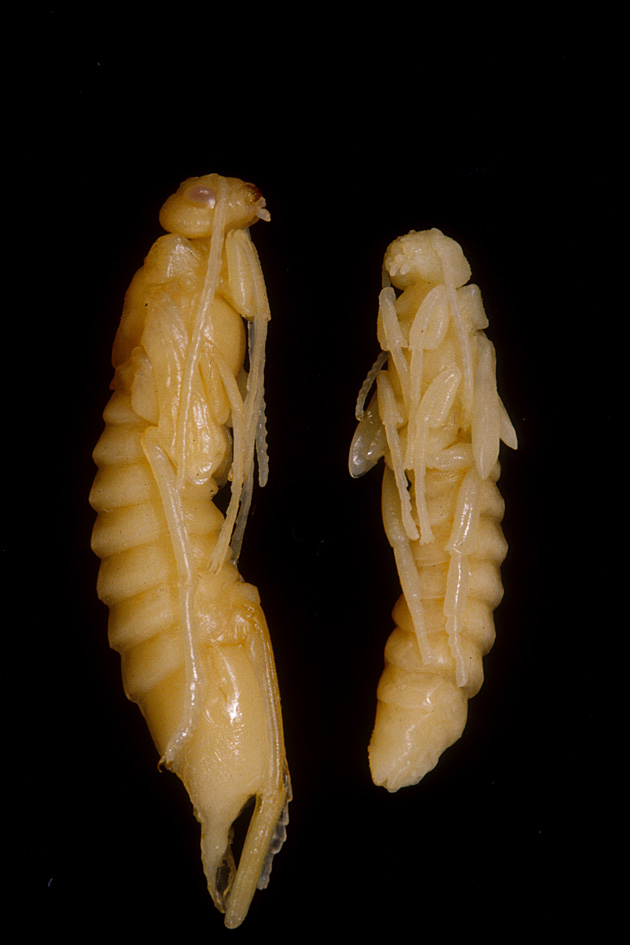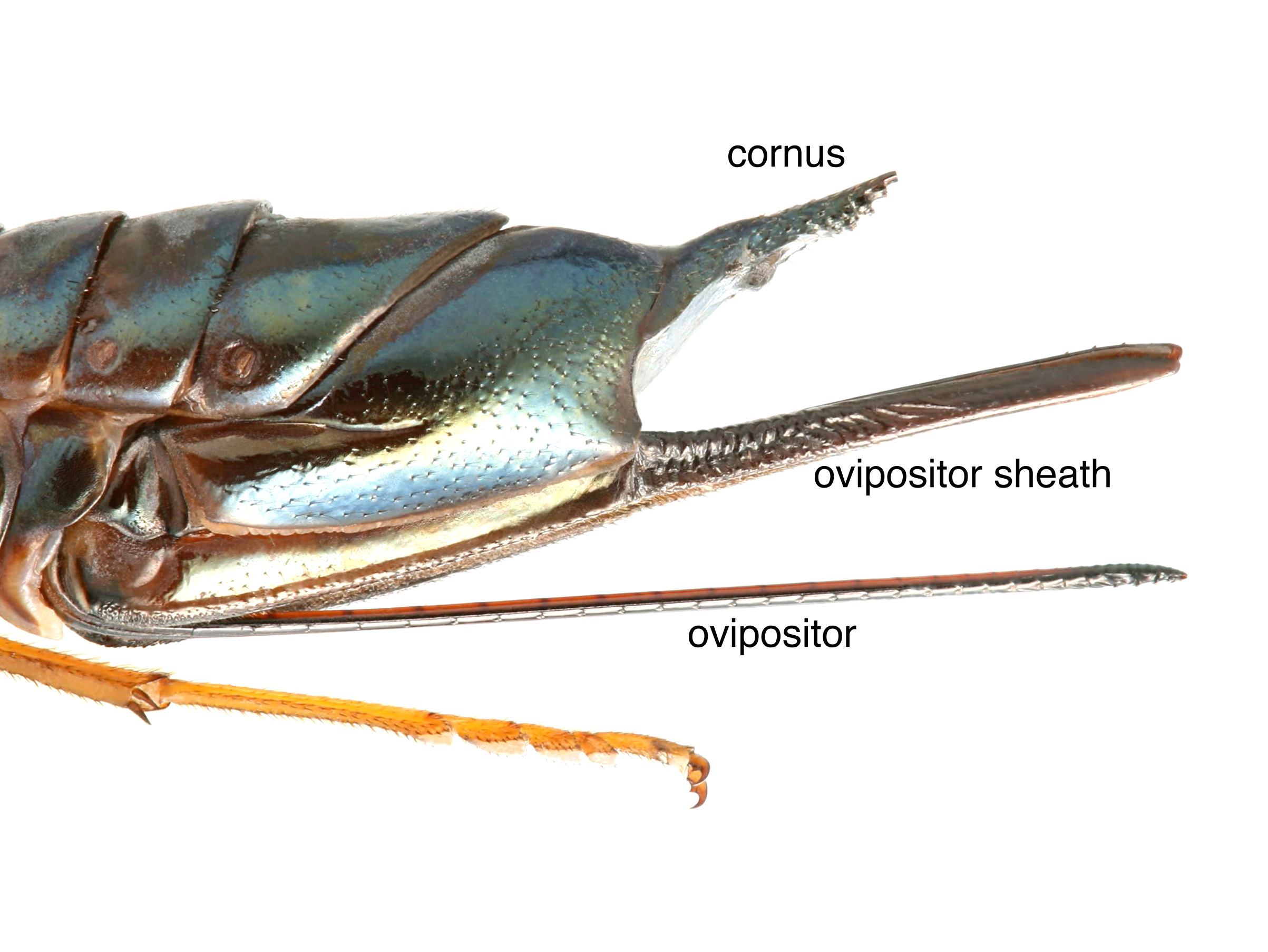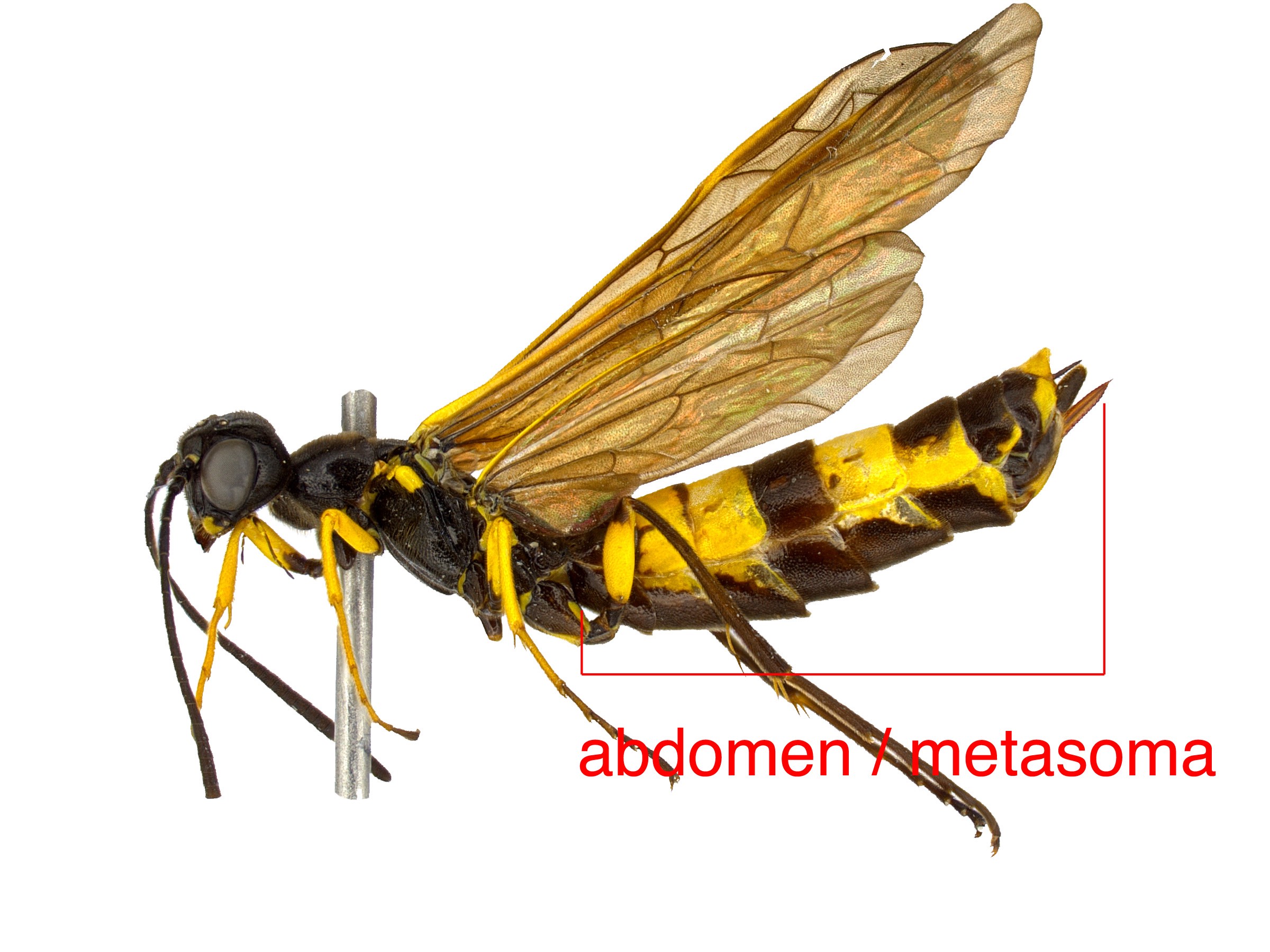Sawflies are a group of Hymenoptera, one of the holometabolous insect orders. Holometabolous insects undergo complete metamorphosis and have four life stages: egg, larvalarva:
the immature stage of holometabolous insects
 , pupapupa:
, pupapupa:
the intermediate and inactive life stage of holometabolous insects, between larva and adult
 , and adult. Female sawflies typically lay eggs on or inside plant tissue using a long, sclerotizedsclerotized:
, and adult. Female sawflies typically lay eggs on or inside plant tissue using a long, sclerotizedsclerotized:
hardened, rigid
ovipositorovipositor:
the female organ that deposits eggs and is used to drill into plant tissue, located at the apex of the abdomen, made up of the lance and lancet
 . The name “sawfly” comes from this distinct ovipositorovipositor:
. The name “sawfly” comes from this distinct ovipositorovipositor:
the female organ that deposits eggs and is used to drill into plant tissue, located at the apex of the abdomen, made up of the lance and lancet
 , which looks and functions similarly to a sawsaw:
, which looks and functions similarly to a sawsaw:
ovipositor
blade. One family, the Orussidae, are parasitic on wood-boring beetles and woodwasps, and lay their eggs on or near their prey.
Examples of the four life stages of a diprionid sawfly:
Examples of an ovipositorovipositor:
the female organ that deposits eggs and is used to drill into plant tissue, located at the apex of the abdomen, made up of the lance and lancet
 “ sawsaw:
“ sawsaw:
ovipositor
”, the egg-laying apparatus of the female sawfly:
The active immature stage in sawflies is the larval stage. LarvaeLarva:
the immature stage of holometabolous insects
 are morphologically distinct from adults. In sawflies, the larvaelarva:
are morphologically distinct from adults. In sawflies, the larvaelarva:
the immature stage of holometabolous insects
 are generally caterpillar-like with visible sclerotizedsclerotized:
are generally caterpillar-like with visible sclerotizedsclerotized:
hardened, rigid
heads, sclerotizedsclerotized:
hardened, rigid
legs attached to the thoraxthorax:
the second and middle segment of the body, between the head and abdomen
 , and fleshy prolegs on their abdomenabdomen:
, and fleshy prolegs on their abdomenabdomen:
the third and last segment of an insect's body; in sawflies this is usually made up of 11 segments (segments 9 and 10 often fused) . The larvaelarva:
. The larvaelarva:
the immature stage of holometabolous insects
 of leaf-mining and wood- or stem-boring taxa, as well as the Pamphiliidae, frequently have reduced or absent legs and prolegs. Like all insects, transitions between life stages occur during a molt. This includes multiple larval stages, or instars, with between five and nine instars across the group.
of leaf-mining and wood- or stem-boring taxa, as well as the Pamphiliidae, frequently have reduced or absent legs and prolegs. Like all insects, transitions between life stages occur during a molt. This includes multiple larval stages, or instars, with between five and nine instars across the group.
The pupal stage occurs during metamorphosis from larvalarva:
the immature stage of holometabolous insects
 to adult. PupaePupa:
to adult. PupaePupa:
the intermediate and inactive life stage of holometabolous insects, between larva and adult
 are largely immobile, and look somewhat like a mummified version of the adult. Legs, wings, and other adult body parts are visible, but are pressed closely to the body and mostly immoveable.
are largely immobile, and look somewhat like a mummified version of the adult. Legs, wings, and other adult body parts are visible, but are pressed closely to the body and mostly immoveable.
Adult sawflies are generally winged, and most species have two sexes. Body form varies widely, from stout, hairy, and bee-like, to long, slender, and wasp-like. Many species have aposematicaposematic:
having warning coloration, indicating that an insect is unpalatable or venemous or otherwise dangerous
coloring and look like their venomous cousins, wasps. While some sawflies can deliver a jarring bite, no species of sawfly can sting.
Sawflies do most of their feeding during their larval stage. Nearly all sawflies feed on plants, in almost every fashion imaginable. Most are external leaf feeders, but many are internal wood borers, stem borers, gall formers, leaf rollers, or leaf miners. Many taxa are characterized by a consistent feeding behavior within their group. For example, most Heterarthrinae in North America are leaf miners, while Siricidae are all wood borers. Wood-boring larvaelarva:
the immature stage of holometabolous insects
 (Siricidae, Xiphydriidae, Anayelidae) are associated with fungal symbionts, which are usually transmitted by ovipositing sawflies. The fungi attack the host plants, and facilitate wood digestion by sawfly larvaelarva:
(Siricidae, Xiphydriidae, Anayelidae) are associated with fungal symbionts, which are usually transmitted by ovipositing sawflies. The fungi attack the host plants, and facilitate wood digestion by sawfly larvaelarva:
the immature stage of holometabolous insects
 or become food themselves. Many sawfly genera are specialists or narrowly oligophagous, feeding only on a single or limited number of plant species. Several genera have diversified in association with a single group of plants, such as Neodiprion on Pinaceae. Other complex groups of closely related genera have diversified across certain plant genera. In North America this is exemplified by the diversity of Nematus, Pontania, and Eurra species associated with willows.
or become food themselves. Many sawfly genera are specialists or narrowly oligophagous, feeding only on a single or limited number of plant species. Several genera have diversified in association with a single group of plants, such as Neodiprion on Pinaceae. Other complex groups of closely related genera have diversified across certain plant genera. In North America this is exemplified by the diversity of Nematus, Pontania, and Eurra species associated with willows.
Sawflies in the subfamily Tenthredininae have been observed feeding on other insects as adults (see page for Rhogogaster and Tenthredo). The only other regularly predaceous sawflies are in the Orussidae, of which some species are parasitoids of wood-boring beetle larvaelarva:
the immature stage of holometabolous insects
 (see page for Orussus).
(see page for Orussus).
Though no sawflies are social in the sense of eusociality exhibited by many bees and wasps, sawfly larvaelarva:
the immature stage of holometabolous insects
 will often feed in aggregations, presumably for defensive purposes. Larval defensive behavior also includes coordinated movements, such as the jerking behavior exhibited by Neodiprion sertifer larvaelarva:
will often feed in aggregations, presumably for defensive purposes. Larval defensive behavior also includes coordinated movements, such as the jerking behavior exhibited by Neodiprion sertifer larvaelarva:
the immature stage of holometabolous insects
 and the toxic compound excretion exhibited by some Arge species.
and the toxic compound excretion exhibited by some Arge species.
external feeding sawfly larvaelarva:
the immature stage of holometabolous insects
 exhibiting defensive “twitching” when they sense nearby movement (Neodiprion sertifer)
exhibiting defensive “twitching” when they sense nearby movement (Neodiprion sertifer)